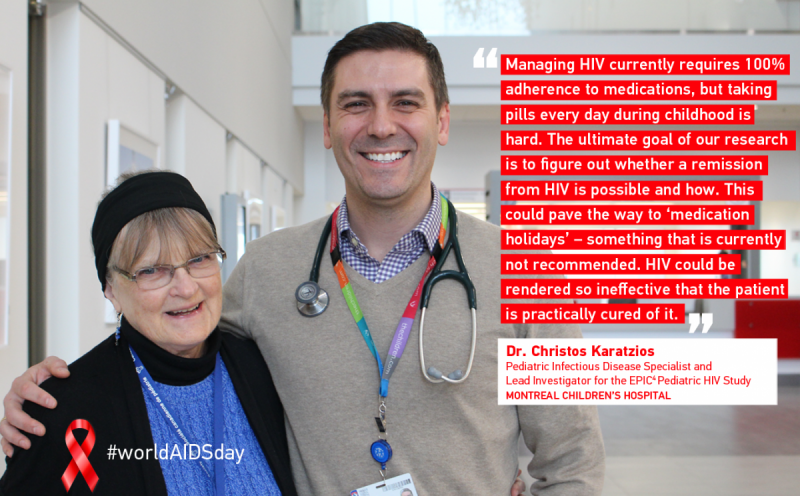Highlighting World AIDS Day
A pan-Canadian pediatric HIV study involving the Montreal Children’s Hospital hopes to pave the way to finding a functional cure

Over the past 25 years, the development of powerful drug combinations has allowed patients born with HIV to live like any other patient managing a chronic illness. But one question that continues to baffle researchers is whether a remission from disease is possible, and how to achieve it.
The ‘Mississippi Baby’
“What we’ve learned from years of studying HIV is that the virus lies dormant in some cells, creating a reservoir that can restart an active infection long after the active virus has been cleared from the blood by treatments,” says Dr. Dr. Christos Karatzios, Pediatric Infectious Disease Specialist. “This is what happened a few years ago to a child from Mississippi who was thought to have been cured of the virus following antiviral treatments. This patient was given powerful drug combinations in the first hours of life and was kept on the regimen until 18 months of age, when she and her mother were lost to care. When they returned after several months, the clinicians were amazed to find that, despite the child's having been off treatment for that period of time, she maintained an undetectable viral load – meaning the HIV virus wasn’t traceable.”
Though her physicians initially thought that she had been cured of HIV, it was found that after several more months off medication, the virus crept back up, and the patient’s viral load increased. There was no “cure” in the purest sense in this case, but researchers began to discuss the possibility of a “functional cure” instead.
Led by HIV researcher, Dr. Hugo Soudeyns at CHU Ste-Justine, the EPIC4 research study brings together a pan-Canadian team of researchers, including MCH physicians Dr. Christos Karatzios, and Dr. Dorothy Moore, to answer this new and hope-filled question in light of the Mississippi baby findings: is HIV viral remission possible and what are the determinants for it?
Combining the expertise of 9 pediatric centres across the country, the investigators hope to recruit 320 patients across Canada, all of whom were treated at different points after being infected with HIV at birth. Thus far, roughly 10 patients have already been recruited to participate at the Children’s, and 150 Canada-wide.
“Some of these patients were offered antiretroviral therapy within the first few hours or days of life, like the Mississippi case, while others were given these treatments within the first year, and some much later,” says Dr. Karatzios. “Our objective is to analyze these patients’ reservoir sites to uncover why one population might be faring better than the other so that we can uncover what approach will allow us to stop medication for a given -- and hopefully prolonged --period of time without the risk of the virus triggering another active infection.”
“Today, managing HIV requires 100% adherence to medications – it’s all or nothing,” he explains. “But taking pills or syrups every day during childhood is hard. The ultimate goal of our research is to figure out whether a remission from HIV is possible and how. This could pave the way to prolonged ‘medication holidays’, which have been rightfully frowned upon by treatment guidelines for years now. But, if we can perhaps prevent a reservoir from forming, we can promote a remission that can allow us to indefinitely stop medications under strict supervision. The hope is that HIV could be rendered so ineffective that the patient is practically cured of it.”


